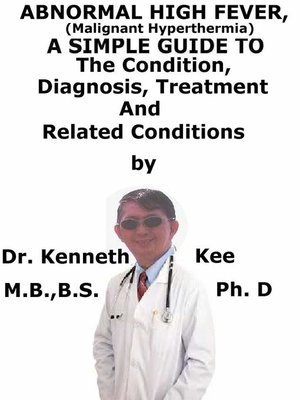Abnormal High Fever (Malignant Hyperthermia), a Simple Guide to the Condition, Diagnosis, Treatment and Related Conditions
ebook
By Kenneth Kee

Sign up to save your library
With an OverDrive account, you can save your favorite libraries for at-a-glance information about availability. Find out more about OverDrive accounts.
Find this title in Libby, the library reading app by OverDrive.



Search for a digital library with this title
Title found at these libraries:
| Library Name | Distance |
|---|---|
| Loading... |
This book describes Abnormal High Fever, Diagnosis and Treatment and Related DiseasesMalignant hyperthermia (or abnormal high fever) is an genetic disorder that produces a rapid increase in body temperature (fever) and severe muscle contractions (myalgia) when the affected person is provides with general anesthesia.This disorder is not the same as hyperthermia due to medical emergencies such as heat stroke.This is a rapid rise in temperature normally activated by an anesthetic and tends to be lethalIt is an inherited myopathy caused by a genetic mutation.Linkage studies reveal that in the majority of families the defect is in the ryanodine receptor gene (RYR1) at chromosome 19q13.1Malignant hyperthermia is an autosomal dominant trait, indicating it needs only one parent carrying the disorder for a child to inherit the disorder.It may be linked with muscular diseases such as multi-mini-core myopathy and central core disease.A form of malignant hyperthermia is produced by a defect in the ryanodine receptor (RYR1) geneMalignant hyperthermia (MH) reactions happen with the onset postponed for several hours into anesthesia using:1. Halothane especially,2. Desflurane,4. Sevoflurane, and5. IsofluraneIt has been limked with:1. Myotonia congenita2. Duchenne muscular dystrophy and3. Becker's muscular dystrophy.Non-depolarizing neuromuscular blockers such as pancuronium are harmless.Nitrous oxide and barbiturates such as thiopental are safe.Symptoms are:1. Rapid rise in temperature to 105 degrees F or higher2. Muscle rigidity and stiffness3. Dark brown urine (myoglobulin)4. Muscle ache without obvious exercise to explain sore musclesOnset may be during or within a few hours after anesthesia.Spasm of the masseter muscle is often first noted.There is muscular rigidity despite a paralyzing agentThere is tachycardia and the skin is flushed.There is hypoxia, hyper-capnea and a metabolic acidosis.Temperature may rise above 40° but normo-thermia does not exclude the condition.Diagnosis:There can be a family history of malignant hyperthermia or non-explained death during anesthesia.Genetic testing is used to institute a diagnosis, but the caffeine halothane contracture test (CHCT) is the criterion standard.Diagnosis is made by the muscle biopsy.Caffeine, halothane, succinylcholine and raised potassium induce amplified contractions.DNA testing cannot be used as the only test for MH susceptibilityTreatmentFor an episode of malignant hyperthermia, a cooling blanket can help reduce fever.The treatment with a drug called dantrolene throughout events of malignant hyperthermia has largely decreased the number of deaths.Dantrolene, the antidote, decreases the loss of calcium from the sarcoplasmic reticulum in the skeletal muscle and restores normal metabolismFluids given orally and intravenously, and certain medicines, are important for maintaining the kidney function during an acute episode.1.Call for help, as management can be difficult and complex for one person.2.Switch from volatile anesthetics to alternative forms of anesthesia.3.Give 100% oxygen and adjust ventilation according to blood gas analysis and end expiratory pCO2.4.Deepen anesthesia with opioids, benzodiazepines, barbiturates or propofol.5.Monitor blood gases, electrolytes, CK, myoglobin and lactate.6.Stop surgery if it is elective and if there are signs of masseter spasm or a fulminant crisis.7.Continue surgery, if there is no hyper-kalemia, no acidosis and there are no triggers.8.Intravenous dantrolene should be given but prophylactic administration of dantrolene is now regarded as obsolete.9.Arrhythmia may be treated with a beta-blocker or lidocaine.TABLE OF CONTENTIntroductionChapter 1 Abnormal High FeverChapter 2 CausesChapter 3...







